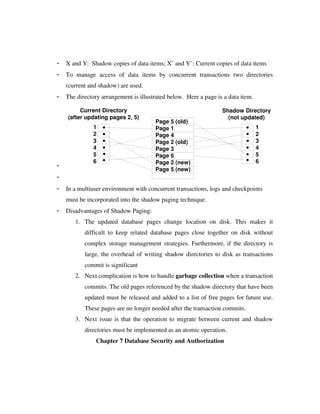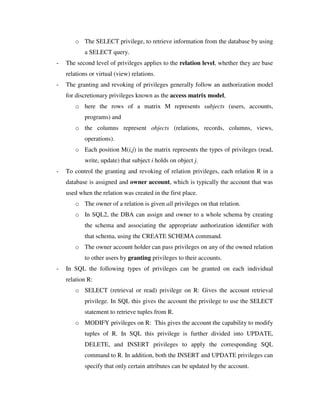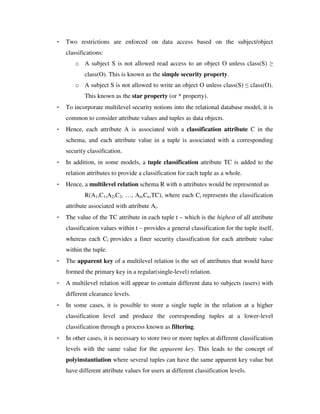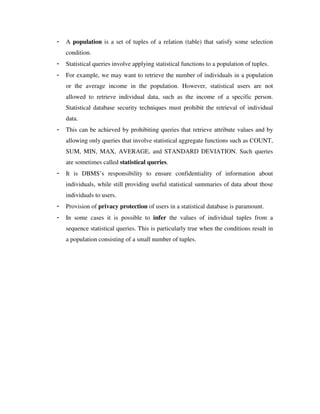This document provides an introduction to object-oriented databases (OODBMS). It discusses key concepts like objects having an identity, structure and type constructor. An OODBMS allows for complex object structures, encapsulation of operations, inheritance and relationships between objects using object identifiers. It provides advantages over traditional databases for applications requiring complex data types and application-specific operations.
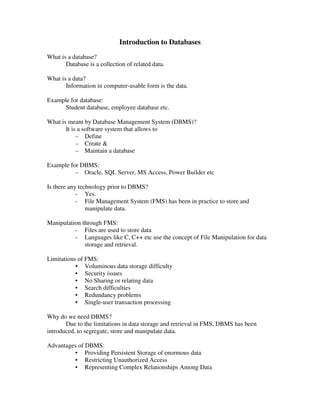
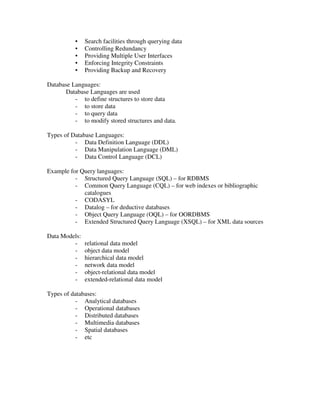
![SQL Commands Overview – 1
Creating Tables:
Syntax:
CREATE TABLE table_name
(
column1 datatype [constraint],
column2 datatype [constraint],
.
.
columnN datatype [constraint]
);
Example:
Create table student( reg_no number(3) primary key, stud_name varchar2(30),
gender varchar2(6), department varchar2(20), year number);
Describing the structure of the table:
Syntax:
DESC table_name;
Eg:
Desc student;
Populating Tables: (to insert data to the table)
Syntax:
INSERT INTO table_name( column1, column2,…, column)
VALUES (value1, value2, …, valueN);
Eg:
Insert into student values(101, ‘Ahemed’, ‘male’, ‘computer science’,2);
Insert into student(reg_no,stud_name) values(102, ‘John’);
Commit;
Note: commit command helps to make the changes permanent.
Retrieval of Information using SELECT command:
Syntax:
SELECT column1, column2,…,column FROM table1, table2, …, tableN
[WHERE condition] [ORDER BY column [ASC| DESC]];](https://image.slidesharecdn.com/advdb-fullhandout-220827141223-11a2c2da/85/Adv-DB-Full-Handout-pdf-3-320.jpg)
![Eg:
Select reg_no, stud_name from student;
Select stud_name from student where reg_no = 101;
Select * from student;
Select * from student where gender = ‘male’;
Select * from student order by reg_no;
Select * from student where gender = ‘female’ and year = 2;
Select * from student where reg_no > 120;
Select distinct stud_name from student;
Modifying data using UPDATE command:
Syntax:
UPDATE table_name SET column1 = new_value1 [, column2=new_val2, …,
columnN=new_valueN] [WHERE condition];
Eg:
Update student set gender =’male’, department = ‘Mathematics’, year =1
Where reg_no = 102;
Update student set stud_name = ‘Syf Ahemed’ where reg_no = 101;
Deleting data in the table:
Syntax:
DELETE FROM table_name [WHERE condition];
Eg:
Delete from student;
Delete from student where reg_no = 101;
Delete from student where gender = ‘female’ and year =4;
Deleting a table structure using DROP command:
Syntax:
DROP TABLE table_name [CASCADE CONSTRAINTS];
Eg:
Drop table student;
Drop table master cascade constraints;](https://image.slidesharecdn.com/advdb-fullhandout-220827141223-11a2c2da/85/Adv-DB-Full-Handout-pdf-4-320.jpg)







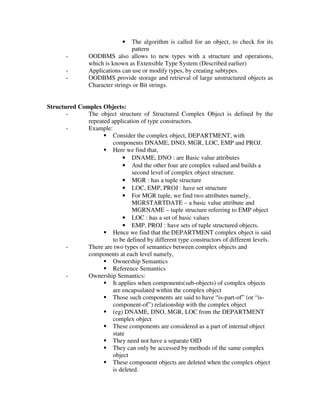




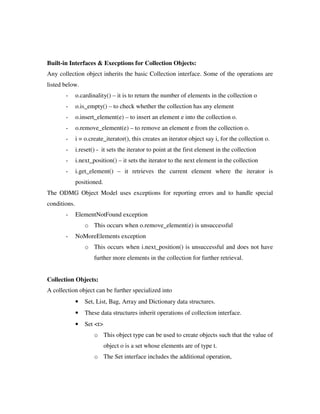









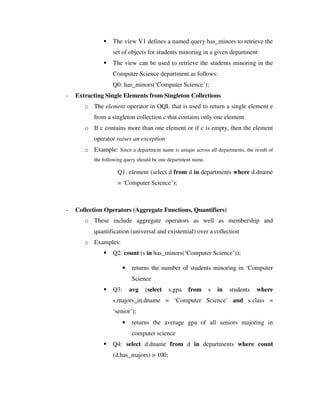





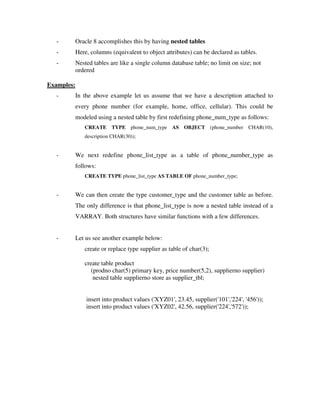














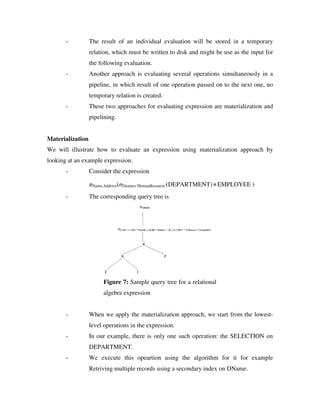

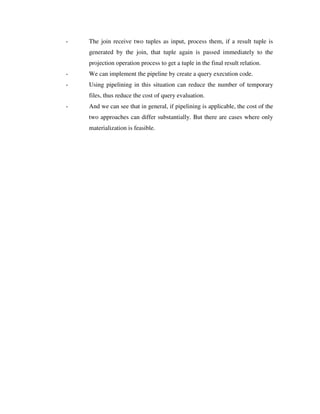

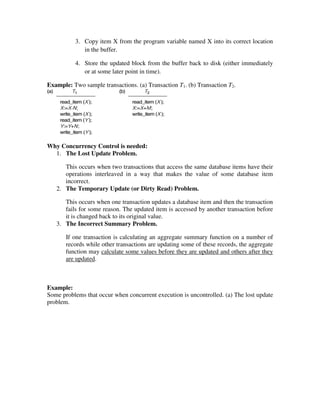

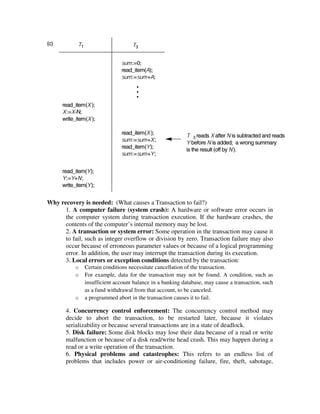

![- In addition, the log is periodically backed up to archival storage (tape) to guard
against such catastrophic failures.
- T in the following discussion refers to a unique transaction-id that is generated
automatically by the system and is used to identify each transaction:
- Types of log record:
1. [start_transaction,T]: Records that transaction T has started execution.
2. [write_item,T,X,old_value,new_value]: Records that transaction T has
changed the value of database item X from old_value to new_value.
3. [read_item,T,X]: Records that transaction T has read the value of
database item X.
4. [commit,T]: Records that transaction T has completed successfully, and
affirms that its effect can be committed (recorded permanently) to the
database.
5. [abort,T]: Records that transaction T has been aborted.
- Protocols for recovery that avoid cascading rollbacks do not require that read
operations be written to the system log, whereas other protocols require these
entries for recovery.
- Strict protocols require simpler write entries that do not include new_value.
Recovery using log records:
If the system crashes, we can recover to a consistent database state by examining the log
and using one of the recovery techniques.
1. Because the log contains a record of every write operation that changes the value
of some database item, it is possible to undo the effect of these write operations
of a transaction T by tracing backward through the log and resetting all items
changed by a write operation of T to their old_values.
2. We can also redo the effect of the write operations of a transaction T by tracing
forward through the log and setting all items changed by a write operation of T
(that did not get done permanently) to their new_values.
Commit Point of a Transaction:
Definition: A transaction T reaches its commit point when all its operations that access
the database have been executed successfully and the effect of all the transaction
operations on the database has been recorded in the log. Beyond the commit point, the
transaction is said to be committed, and its effect is assumed to be permanently recorded
in the database. The transaction then writes an entry [commit,T] into the log.](https://image.slidesharecdn.com/advdb-fullhandout-220827141223-11a2c2da/85/Adv-DB-Full-Handout-pdf-56-320.jpg)
![Roll Back of transactions: Needed for transactions that have a [start_transaction,T]
entry into the log but no commit entry [commit,T] into the log.
Redoing transactions: Transactions that have written their commit entry in the log must
also have recorded all their write operations in the log; otherwise they would not be
committed, so their effect on the database can be redone from the log entries. (Notice that
the log file must be kept on disk. At the time of a system crash, only the log entries that
have been written back to disk are considered in the recovery process because the
contents of main memory may be lost.)
Force writing a log: before a transaction reaches its commit point, any portion of the
log that has not been written to the disk yet must now be written to the disk. This process
is called force-writing the log file before committing a transaction.
Desirable Properties of Transactions
ACID properties:
- Atomicity: A transaction is an atomic unit of processing; it is either
performed in its entirety or not performed at all.
- Consistency preservation: A correct execution of the transaction must
take the database from one consistent state to another.
- Isolation: A transaction should not make its updates visible to other
transactions until it is committed; this property, when enforced strictly,
solves the temporary update problem and makes cascading rollbacks of
transactions unnecessary.
- Durability or permanency: Once a transaction changes the database and
the changes are committed, these changes must never be lost because of
subsequent failure.
Characterizing Schedules based on Recoverability
- Transaction schedule or history: When transactions are executing
concurrently in an interleaved fashion, the order of execution of operations
from the various transactions forms what is known as a transaction
schedule (or history).
- A schedule (or history) S of n transactions T1, T2, ..., Tn :
- It is an ordering of the operations of the transactions subject to the
constraint that, for each transaction Ti that participates in S, the operations
of T1 in S must appear in the same order in which they occur in T1. Note,
however, that operations from other transactions Tj can be interleaved
with the operations of Ti in S.
Schedules classified on recoverability:
- Recoverable schedule: One where no transaction needs to be rolled back.](https://image.slidesharecdn.com/advdb-fullhandout-220827141223-11a2c2da/85/Adv-DB-Full-Handout-pdf-57-320.jpg)


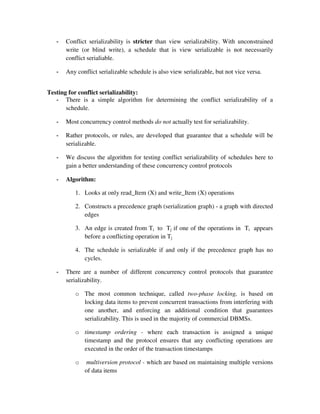

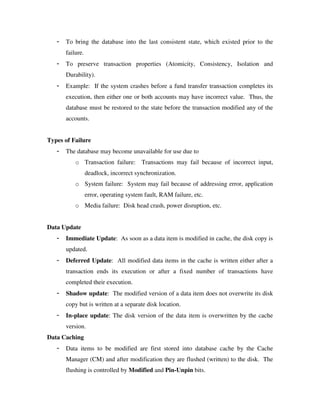
![- Pin-Unpin: Instructs the operating system not to flush the data item.
- Modified: Indicates the AFIM of the data item.
Transaction Roll-back (Undo) and Roll-Forward (Redo)
- To maintain atomicity, a transaction’s operations are redone or undone.
- Undo: Restore all BFIMs on to disk (Remove all AFIMs).
- Redo: Restore all AFIMs on to disk.
- Database recovery is achieved either by performing only Undos or only Redos or
by a combination of the two. These operations are recorded in the log as they
happen.
Write-Ahead Logging
- When in-place update (immediate or deferred) is used then log is necessary for
recovery and it must be available to recovery manager. This is achieved by
Write-Ahead Logging (WAL) protocol. WAL states that
- For Undo: Before a data item’s AFIM is flushed to the database disk (overwriting
the BFIM) its BFIM must be written to the log and the log must be saved on a
stable store (log disk).
- For Redo: Before a transaction executes its commit operation, all its AFIMs must
be written to the log and the log must be saved on a stable store.
Checkpointing
- Another type of entry in the log is called a checkpoint
- A [checkpoint] record is written into the log periodically at that point when
the system writes out to the database on disk all DBMS buffers that have been
modified.
- As a consequence of this, all transactions that have their [commit, T] entries in the
log before a [checkpoint] entry do not need to have their WRITE operations
redone in case of a system crash, since all their updates will be recorded in the
database on disk during checkpointing](https://image.slidesharecdn.com/advdb-fullhandout-220827141223-11a2c2da/85/Adv-DB-Full-Handout-pdf-63-320.jpg)
![- The recovery manager of a DBMS must decide at what intervals to take a
checkpoint.
- Time to time (randomly or under some criteria) the database flushes its buffer to
database disk to minimize the task of recovery. The following steps defines a
checkpoint operation:
Suspend execution of transactions temporarily.
Force-write modified buffer data to disk.
• Write a [checkpoint] record to the log, save the log to disk.
• Resume normal transaction execution.
- During recovery redo or undo is required to transactions appearing after
[checkpoint] record.
- A checkpoint record in the log may also include additional information, such as a
list of active transaction ids, and the locations (addresses) of the first and most
recent (last) records in the log for each active transaction.
- This can facilitate undoing transaction operations in the event that a transaction
must be rolled back.
- The time needed to force-write all modified memory buffers may delay
transaction processing because of Step 1. To reduce this delay, it is common to
use a technique called fuzzy checkpointing in practice.
In this technique, the system can resume transaction processing
after the [checkpoint] record is written to the log without having to
wait for Step 2 to finish.
However, until Step 2 is completed, the previous [checkpoint]
record should remain to be valid. To accomplish this, the system
maintains
a pointer to the valid checkpoint, which continues to point to the
previous [checkpoint] record in the log.
Once Step 2 is concluded, that pointer is changed to point to the
new checkpoint in the log.](https://image.slidesharecdn.com/advdb-fullhandout-220827141223-11a2c2da/85/Adv-DB-Full-Handout-pdf-64-320.jpg)

![•At commit point under WAL scheme these updates are saved on database
disk.
- After reboot from a failure the log is used to redo all the transactions affected by
this failure. No undo is required because no AFIM is flushed to the disk before a
transaction commits.
- A set of transactions records their updates in the log.
- At commit point under WAL scheme these updates are saved on database disk.
- After reboot from a failure the log is used to redo all the transactions affected by
this failure. No undo is required because no AFIM is flushed to the disk before a
transaction commits.
Deferred Update in a single-user system
Example:
(a) T1 T2
read_item (A) read_item (B)
read_item (D) write_item (B)
write_item (D) read_item (D)
write_item (A)
(b)
[start_transaction, T1]
[write_item, T1, D, 20]
[commit T1]
[start_transaction, T1]
[write_item, T2, B, 10]
[write_item, T2, D, 25] ← system crash
- Here the [write_item, …] operations of T1 are redone.
- T2 log entries are ignored by the recovery manager.
- The redo procedure is defined as follows:](https://image.slidesharecdn.com/advdb-fullhandout-220827141223-11a2c2da/85/Adv-DB-Full-Handout-pdf-66-320.jpg)
![- REDO(WRITE_OP): Redoing a write_item operation WRITE_OP consists of
examining its log entry [write_item, T, X, new_value] and setting the value of
item X in the database to new_value, which is the after image (AFIM).
- The REDO operation is required to be idempotent—that is, executing it over and
over is equivalent to executing it just once. In fact, the whole recovery process
should be idempotent. This is so because, if the system were to fail during the
recovery process, the next recovery attempt might REDO certain write_item
operations that had already been redone during the first recovery process. The
result of recovery from a system crash during recovery should be the same as the
result of recovering when there is no crash during recovery!
Deferred Update with concurrent users
- This environment requires some concurrency control mechanism to guarantee
isolation property of transactions.
- In a system recovery transactions which were recorded in the log after the last
checkpoint were redone.
- The recovery manager may scan some of the transactions recorded before the
checkpoint to get the AFIMs.
- Two tables are required for implementing this protocol:
- Active table: All active transactions are entered in this table.
- Commit table: Transactions to be committed are entered in this table.
- During recovery, all transactions of the commit table are redone and all
transactions of active tables are ignored since none of their AFIMs reached the
database. It is possible that a commit table transaction may be redone twice but
this does not create any inconsistency because of a redone is “idempotent”, that
is, one redone for an AFIM is equivalent to multiple redone for the same AFIM.
Recovery Techniques Based on Immediate Update](https://image.slidesharecdn.com/advdb-fullhandout-220827141223-11a2c2da/85/Adv-DB-Full-Handout-pdf-67-320.jpg)

![- Recovery schemes of this category apply undo and also redo for recovery.
- In a single-user environment no concurrency control is required but a log is
maintained under WAL (Write-Ahead –Logging).
- Note that at any time there will be one transaction in the system and it will be
either in the commit table or in the active table.
- The recovery manager performs:
1. Undo of a transaction if it is in the active table.
2. Redo of a transaction if it is in the commit table.
- The UNDO procedure is defined as follows:
- UNDO(WRITE_OP): Undoing a write_item operation WRITE_OP consists of
examining its log entry [write_item, T, X, old_value, new_value] and setting the
value of item X in the database to old_value which is the before image (BFIM).
Undoing a number of write_item operations from one or more transactions from
the log must proceed in the reverse order from the order in which the operations
were written in the log.
Undo/Redo Algorithm (Concurrent execution)
- Recovery schemes of this category applies undo and also redo to recover the
database from failure.
- In concurrent execution environment a concurrency control is required and log is
maintained under WAL.
- Commit table records transactions to be committed and active table records active
transactions.
- To minimize the work of the recovery manager checkpointing is used. The
recovery performs:
1. Undo of a transaction if it is in the active table.
2. Redo of a transaction if it is in the commit table.
Shadow Paging](https://image.slidesharecdn.com/advdb-fullhandout-220827141223-11a2c2da/85/Adv-DB-Full-Handout-pdf-69-320.jpg)

